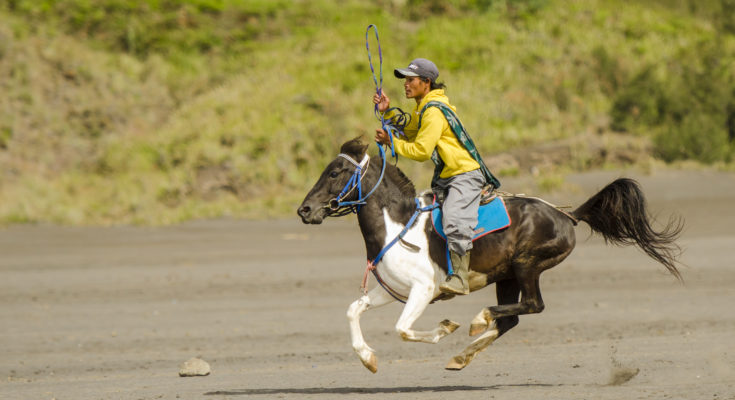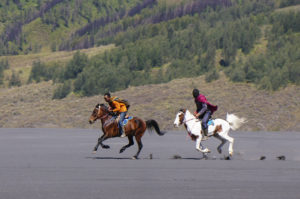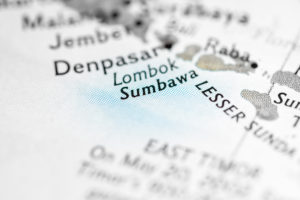by Yuli Andari M.
| Sumbawa is inextricably associated with horses—not least because of a bombastic advertising campaign for the powers of “the milk of Sumbawa’s wild horses” (susu kuda liar Sumbawa). Sumbawan horses are small—almost large ponies—with characteristically cute bodies. They stand only about a meter and a half at the withers. Some people call them ‘bonsai horses’. For the Sumbawanese, horses are a key economic asset, with horse-power being used for load-carrying, for transportation, and also for racing.
Sumbawa is one of the most important islands in the Indonesian province of West Nusa Tenggara. It is divided into four kabupaten (regencies): Sumbawa; Dompu; Bima; and the new regency of Sumbawa Barat. The climate is dry, with an arable soil that supports some forest and much grassland, making it suitable for farming and raising livestock. Most of the islanders work this land as wetland (sawah) or dry fields with plenty of grass, good for grazing livestock such as cows, water buffalo, horses and goats. The farmers simply keep an eye on their herds from under a tree, or from a bale orong (a small hut in the middle of a field) and, when the sun begins to set, the animals are led home. Horses have been part of life in Sumbawan society for a very long time. Local folktales portray this close friendship, although there are accounts that this relationship was once severely tested. Bernice de Jong Boer, a Dutch anthropologist, in Mount Tambora 1815: a volcanic eruption in Indonesia and its aftermath, writes that a year after the eruption of Mount Tambora, there was widespread famine. Some 95% of the ripened rice-crop, which was ready to harvest, was lost. The people of Sumbawa sought out anything to fill their empty bellies, including tree bark, poisonous roots, and horsemeat. These days, one does not hear of Sumbawanese eating horses. The people feel that there is far more advantage in taking care of horses than in eating them. A horse is still a valuable asset, and it can bring its owner wealth and prestige—especially if the horse often wins at the races (Maen Jaran). Originally, Maen Jaran was part of celebrations at the end of the harvest in Sumbawa. Like horse racing everywhere, it is a way of proving a horse’s excellence: his speed and spirit—and it is a social sport that brings horse breeders together. In Sumbawa, horse racing has developed into a popular recreation, managed by the local people themselves. Nowadays, the races are held not only to mark the end of the harvest, but also at other celebrations such as Indonesian Independence Day, Armed Forces Day (Hari ABRI), Police Day (Hari Kepolisian), Heroes Day (Hari Pahlawan) or the annual anniversary of Sumbawa Regency. The racetrack is a lively place, and there are practice races for months before the start of a big event of this kind. The race meets—which are held over the duration of a week and last from morning until sunset—draw hundreds of horses from all over Sumbawa Regency and the rest of the island. The run-up to a Maen Jaran requires full preparation, a concentration of money and thought. Both money and prestige will be risked, can be won or lost, at the racetrack. Millions of rupiah will be dredged out of wallets during the event. According to Jaya Pranata, aged thirty-five, “My total expenditure for a single race can reach more than five million rupiah, depending on its location. It’s Rp1 million just for transporting the horses, before the costs of food and care”. He allocates Rp2 million a month for the cost of keeping his eleven horses, not including the wages of his stable boys. Pak Palawa, aged fifty, tells a different story. Every day, he tends his horse himself; there is almost no separate budget for the horse. He cuts grass for feed along the edges of garden plots or just lets the horse graze beside the house. He leaves to his children the chores of cleaning out the stable and washing down the horse, so it’s only at race time that his expenditure escalates. Still, he always finds a strategic solution. This time, the race is located some one hundred kilometers from his home in Taliwang, so he stays in a tent. He brings food from home: six gantung of rice (1 gantung = 3 kg), to be accompanied by salt fish and spicy sauce (sambal). He cooks this himself, taking turns with others who have come along from Taliwang. Indeed, during the racing period, participants often camp in the open with their wives and children. Smoke rises from cooking fires. Palawa and his group sit in a circle eating warm rice, salt fish and sambal in the open air. “During the Maen Jaran, most of the money and attention goes on the horse,” Palawa says. “I only hope he wins.” The expense of the owners far exceeds the value of the prize they might win. Usually the prizes are televisions, VCD players or other homewares, sarongs, or cash. Nonetheless, the enthusiasts keep coming to the races. The prestige of winning is invaluable. And if a horse is on a winning streak, his worth can rise five to ten times over. A certain owner once told me that he bought his horse for Rp6 million, but was confident that the horse had earned itself a reputation worth Rp20 million or maybe more. It’s not only the owners who are mad about horse racing. Spectators also enjoy the bustling energy and atmosphere. The final stages of a race may draw spectators by the thousands, no matter how far, or how bad the roads they must travel. Often a group will pool their resources to hire a truck to bring them to the racetrack, and they out camp out in the grounds. Pak Saleh, who lives in Desa Langam (Taliwang) where this race meet is taking place, has moved his family into the bale orong hut in the middle of his fields near the race course. Besides loving the races, he finds it an inexpensive way to have a holiday with his family. Although he often spends the night in this rustic little hovel, especially during the planting season, he brings his wife and children along during the race meet. “It’s been a while since we’ve had some fun together as a family. Camping out here near the race course is exciting. Besides it’s been a long time since they’ve seen these fields—only once before!” says Pak Saleh. His wife nods happily. At the racetrack, a lot happens before the break of dawn. Before sunrise the grooms have bathed their horses in a nearby brook, carefully washing their heads, bodies, tails and feet. Often the grooms get into water to bathe with them; and sometimes they burst into spontaneous lawas (a kind of comic poetry) to brighten the horses’ mood. After their bath, the horses are fed a mixture of rice and bran called dedak, and a special kind of grass called rebu burin which is believed to make horses strong. Before races, some people supplement their horses’ diets with the famous energy drink Hemaviton, which is believed to enhance the horses’ speed. Besides the owners and grooms, other important figures are the juki (jockeys), the sandro (a kind of dukun or healer) and the pelepas (who release the horses at the starting line). In Sumbawanese horse racing, the jockeys are young boys between the ages of five and eleven years old. They are small in stature, thin and light, like the ‘bonsai horses’ they ride. The sandro are responsible for evaluating and choosing the right jockey. Usually, they assess the child’s physique, his eyesight, and the shape of his legs. Sometimes, they also base their judgment on a jockey’s ancestry. However, the most important qualities these small jockeys must possess are courage and agility in their riding style. The horses and riders practice according to a schedule set out by their sandro. The jockeys are expert riders, first taught to ride by their fathers or grandfathers. Anto, ten years old, was taught by his grandfather, who is also a sandro. The first time Anto saw a horse, he was terrified. He was afraid to ride, and didn’t even dare walk past a horse, for fear of being kicked. But his grandfather taught to know a horse’s nature, to ride bareback, to understand the agility and wildness of the animal, and how to use his whip. “My grandfather told me that I must not hit them too hard, because they’ll get angry,” he says. When Anto began to ride, he lost count of how many times he fell off. His elbows, shoulders and face were often scraped and he even suffered broken bones. But he was undaunted. After five years, he became a jockey. When the races begin, the little jockeys put on numbers in order to simplify the judge’s work. Their clothing is simple—tracksuits, socks without sandals, special masks to cover their heads and noses, and a small helmet. They carry rattan whips, of about one centimeter in diameter. Since the horses don’t wear saddles, their backs become slippery and the jockeys often fall. The jockey receives a professional fee from the horse’s owner, and can be contracted for as long as the duration of a particular race meet, or for each individual ride. As they are still children, their parents handle the contracts and the various necessary details. Jockeys can take between Rp500,000 and Rp750,000 per meet, or Rp10,000 to 50,000 per ride. If they win, they get a bonus—prizes such as money, sarongs, a television, or even a horse. Nine-year-old Herman won a horse when he became ‘best jockey’ last year. Sadly, he couldn’t race it this year because it was lame. Besides their role in training the horses and jockeys, sandro are also involved in selecting horses to be trained for racing. The horse’s build, the length of his stride, and or even the shape of the eyes or the position of the navel, can all indicate the nature of a fine horse. Prior to the race, the sandro bathes and prays over the jockey before he mounts. The sandro transfers his inner energy to the jockey through mantras, which then settle in the jockey’s mind. There is a belief that the sandro are the real actors behind the successes and failures at the races. Meanwhile the pelapas is at the starting line, where he gives the countdown to the horse and rider. Often the horse’s groom will act as pelapas. This is a vital role on the race course. He will help calm the horse, who is sometimes difficult before the start of a race. Each horse has its own pelapas. When the whistle blows, the pelapas slaps the horse’s behind so that it runs fast and strong. Horse racing wouldn’t be so exciting if there weren’t any gambling—an open secret among racing fans in Sumbawa. The bettors work in groups that pool their bets and wager a total of anywhere from 10,000 to 100,000 rupiah. In the final stages of the race, the bets go up. Some people even bet their motorbikes. Usually, people back a particular horse or, if they are the owner, they obviously back their own. If their horse crosses the finish line first, they get the winnings. In every Maen Jaran, hundreds of horses from all over Sumbawa compete. The horses are grouped into five classes, based on their age and height. They will compete for the title of best horse in each of class. There are six horses in each race. The horses race around a wide, circular track. The spectators watch from the inner enclosure, which is fenced off with meter-high bamboo, cheering their favorites. Pak Nur, a spectator, is rooting for Ben Johnson, a horse from Bima regency. “He has all the signs of a great race horse: long legs and a big stride,” he says. Asked if he has also placed a bet, he smiles. “No way. I’m just a spectator. I used to gamble because it’s not nice to turn down your friends. But not any more.” The racetrack exerts a powerful charm. Most of the gamblers know each other, since they attend every Maen Jaran to hazard their fortunes. Screams of excitement, applause, cheers, and vows of all kinds throb in the air as the little horses pound around the track in a storm of dust. The sights and sounds of the Maen Jaran ends with the setting of the sun. Spectators leave the racetrack with weary faces. The hawkers pack up their wares and bamboo kiosks. Horse owners, jockeys, sandro and grooms prepare the horses for the ride home. All say fare-well and promise to meet again. Yuli Andari M is a librarian at the KUNCI Cultural Studies Centre in Jogjakarta. |













